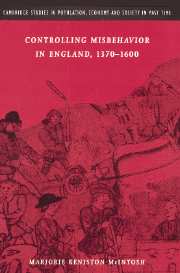Book contents
- Frontmatter
- Contents
- 1 List of illustrations
- 2 List of tables and lists
- Acknowledgements
- List of abbreviations
- Introduction
- Part I The history of social regulation
- Part II Factors that influenced social regulation
- 5 Some political considerations
- 6 Social ecology I: “broad response” and “no response” communities
- 7 Social ecology II: analysis by type of offences reported
- 8 Ideological/religious influences
- Conclusion: social regulation and the transition from medieval to early modern England
- Appendices
- Bibliography
- Index
- Cambridge Studies in Population, Economy and Society in Past Time
6 - Social ecology I: “broad response” and “no response” communities
Published online by Cambridge University Press: 23 November 2009
- Frontmatter
- Contents
- 1 List of illustrations
- 2 List of tables and lists
- Acknowledgements
- List of abbreviations
- Introduction
- Part I The history of social regulation
- Part II Factors that influenced social regulation
- 5 Some political considerations
- 6 Social ecology I: “broad response” and “no response” communities
- 7 Social ecology II: analysis by type of offences reported
- 8 Ideological/religious influences
- Conclusion: social regulation and the transition from medieval to early modern England
- Appendices
- Bibliography
- Index
- Cambridge Studies in Population, Economy and Society in Past Time
Summary
Another set of potential influences upon the amount of social wrongdoing and efforts to control it consists of the geographic, demographic, and economic circumstances of individual communities. To explore the impact of these factors, we will focus on the 255 places (containing 267 courts) whose records were used in Chapter 3, linking up evidence about their responses to misconduct with other sorts of information. Chapters 6 and 7 both present quantitative analyses of such features as the type of community, its regional setting and specific location, the nature of its economy, the size and direction of population movement, the level of total wealth and changes in prosperity over time, and the distribution of resources among its residents. Chapter 6 compares places that reported a broad array of behavioral offences with those that mentioned no problems at all within three chronological periods; Chapter 7 divides the communities into groups based upon the type of offences they presented and then examines their characteristics during four pivotal duodecades. Because each of these approaches involves breaking down the full set of communities into smaller subsets within periods, the number of places within the individual groupings is almost never larger than 100 and more commonly is less than 50. Since these numbers are so small in statistical terms, common sense indicates that mathematical measures of significance and correlation not be presented: I do not want to imply that the figures allow us to assess in a quantitative fashion the precise role played by each of the factors considered. Instead we will compare groups of communities based upon their level and type of concern with misconduct in order to identify patterns, similarities, and contrasts.
- Type
- Chapter
- Information
- Controlling Misbehavior in England, 1370–1600 , pp. 137 - 169Publisher: Cambridge University PressPrint publication year: 1998



